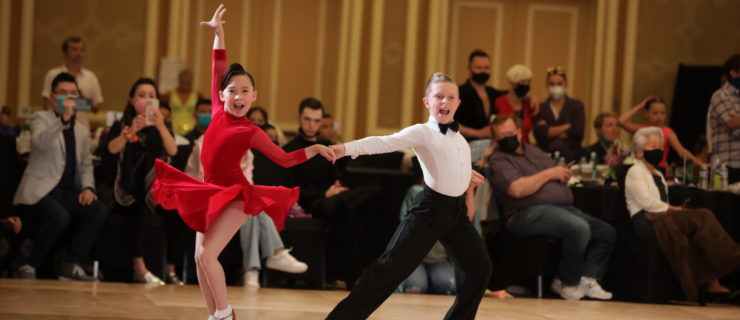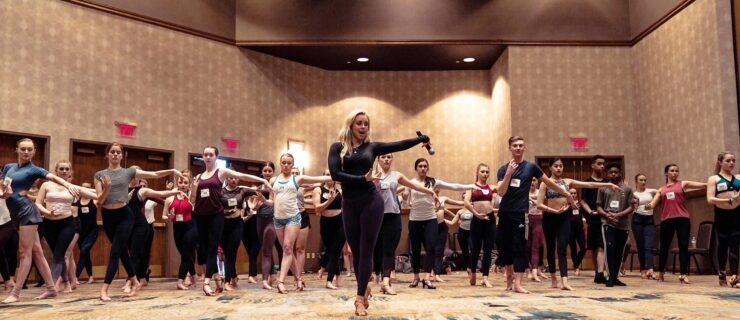Ballroom Basics
Whatever your specialty as a dancer, there’s no doubt being well-rounded will get you far, and ballroom dance is an increasingly important piece of that versatility. Just watch “So You Think You Can Dance,” where the contestants who stick around longest are those who breeze through a tough contemporary routine and make an intricate cha-cha number look easy. Or look at New York City Ballet, whose company members are called upon to dance ballroom-inspired works like George Balanchine’s Vienna Waltzes, or I’m Old Fashioned, Jerome Robbins’ tribute to Fred Astaire.
While you may not want to become a ballroom expert, there are a few steps every dancer should know. We asked some of ballroom’s familiar faces to share their must-master moves.
Step #1: New Yorkers
Recommended by: Afton DelGrosso (DS January 2011), who danced in Le Rêve and performed on “Dancing with the Stars” during the “Pick a Pro” competition in Season 8.
What it looks like: You’ll see this four-count move in the cha-cha. You and your partner start facing each other, holding hands at waist height. On the second count, release your downstage hands and step toward the audience with your upstage foot. On the third count, step back to face each other and join hands again. Then, in a quick triplet, chassé upstage on counts four-and-one. Reverse the entire sequence, opening and stepping away from the audience again on count two. “New Yorkers are such a recognizable step because they’re a staple in every cha-cha routine,” Afton says. “They really teach you the cha-cha timing.”
Afton’s Technique Tips:
- “Focus on the rhythm,” Afton says, “so you and your partner are opening and closing at the same time.”
- Keep your legs straight.
- Stay close to your partner, Afton says, “otherwise it looks like a big, wide door swinging open and closed.”
Step #2: Box Step
Recommended by: Anya Garnis from “So You Think You Can Dance” Season 3, Burn the Floor and “Superstars of Dance.”
What it looks like: A typical box-step sequence uses a basic foot pattern of forward-side-together and back-side-together in counts of three. Step forward with the left foot, to the side with the right foot and together again with the left. Then step back with the right foot, to the side with the left foot and together with the right. Anya says the box step, which shows up in many styles, is the first thing she teaches in ballroom lessons.
Anya’s Technique Tips:
- The box step should look completely different in each ballroom style. For instance, the rumba box step is “very earthy with hip action,” Anya says, while the waltz version features a graceful rise and fall, and the fox-trot box can be “somewhat bouncy.”
- The type of dance will also determine how you place your foot when stepping and transferring weight. In the rumba and other Latin styles, you place your toe before your heel. In the waltz, fox-trot and tango, you step onto your heel, and then place your toe.
- “Control the standing leg as you’re transferring weight,” Anya says. “That control is crucial and defines the regular box step.”
Step #3: Cucaracha
Recommended by: “So You Think You Can Dance” judge Mary Murphy, who also runs her own studio, San Diego’s Champion Ballroom Academy.
What it looks like: In this step, which you’ll see in the rumba, cha-cha, samba and mambo, you face your partner and hold hands while stepping in a quick-quick-slow pattern. You step to the side with your right foot, shift your weight onto your left foot, then step together with your right foot. Then you reverse the sequence. As you step from side to side, your hips move in a figure-eight pattern.
Mary’s Technique Tips:
- “Make sure you go from the balls of your feet to the heels,” Mary says. “Plant the ball, lower the heel and straighten into the leg.”
- Mary warns that many dancers can be “choppy” when executing a cucaracha. Be sure to keep your movement fluid and continuous.
- “Put a book on top of your head and try to keep your head flat in the midst of all the hip movement,” Mary suggests. “You want your head to be still.”



